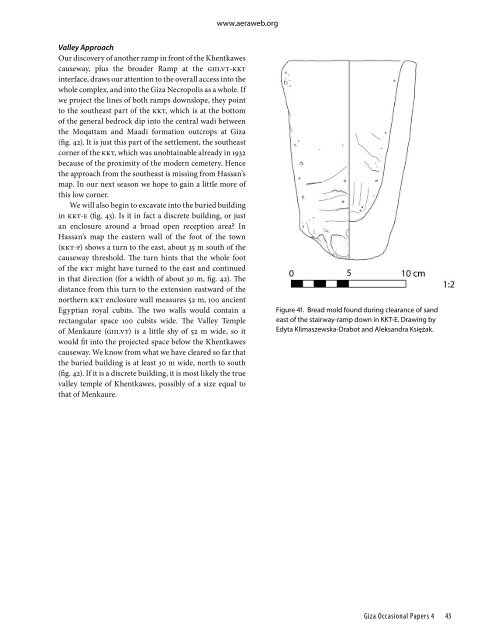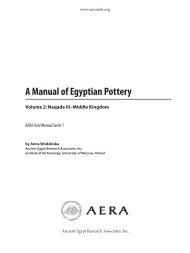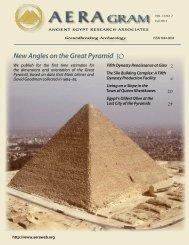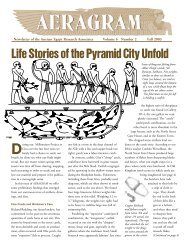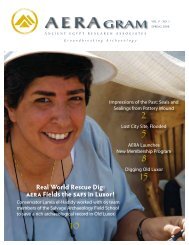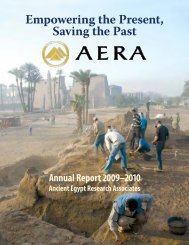The Khentkawes Town (KKT) - Ancient Egypt Research Associates
The Khentkawes Town (KKT) - Ancient Egypt Research Associates
The Khentkawes Town (KKT) - Ancient Egypt Research Associates
You also want an ePaper? Increase the reach of your titles
YUMPU automatically turns print PDFs into web optimized ePapers that Google loves.
www.aeraweb.org<br />
Valley Approach<br />
Our discovery of another ramp in front of the <strong>Khentkawes</strong><br />
causeway, plus the broader Ramp at the GIII.VT-<strong>KKT</strong><br />
interface, draws our attention to the overall access into the<br />
whole complex, and into the Giza Necropolis as a whole. If<br />
we project the lines of both ramps downslope, they point<br />
to the southeast part of the <strong>KKT</strong>, which is at the bottom<br />
of the general bedrock dip into the central wadi between<br />
the Moqattam and Maadi formation outcrops at Giza<br />
(fig. 42). It is just this part of the settlement, the southeast<br />
corner of the <strong>KKT</strong>, which was unobtainable already in 1932<br />
because of the proximity of the modern cemetery. Hence<br />
the approach from the southeast is missing from Hassan’s<br />
map. In our next season we hope to gain a little more of<br />
this low corner.<br />
We will also begin to excavate into the buried building<br />
in <strong>KKT</strong>-E (fig. 43). Is it in fact a discrete building, or just<br />
an enclosure around a broad open reception area In<br />
Hassan’s map the eastern wall of the foot of the town<br />
(<strong>KKT</strong>-F) shows a turn to the east, about 35 m south of the<br />
causeway threshold. <strong>The</strong> turn hints that the whole foot<br />
of the <strong>KKT</strong> might have turned to the east and continued<br />
in that direction (for a width of about 30 m, fig. 42). <strong>The</strong><br />
distance from this turn to the extension eastward of the<br />
northern <strong>KKT</strong> enclosure wall measures 52 m, 100 ancient<br />
<strong>Egypt</strong>ian royal cubits. <strong>The</strong> two walls would contain a<br />
rectangular space 100 cubits wide. <strong>The</strong> Valley Temple<br />
of Menkaure (GIII.VT) is a little shy of 52 m wide, so it<br />
would fit into the projected space below the <strong>Khentkawes</strong><br />
causeway. We know from what we have cleared so far that<br />
the buried building is at least 30 m wide, north to south<br />
(fig. 42). If it is a discrete building, it is most likely the true<br />
valley temple of <strong>Khentkawes</strong>, possibly of a size equal to<br />
that of Menkaure.<br />
Figure 41. Bread mold found during clearance of sand<br />
east of the stairway-ramp down in <strong>KKT</strong>-E. Drawing by<br />
Edyta Klimaszewska-Drabot and Aleksandra Księżak.<br />
Giza Occasional Papers 4 43


